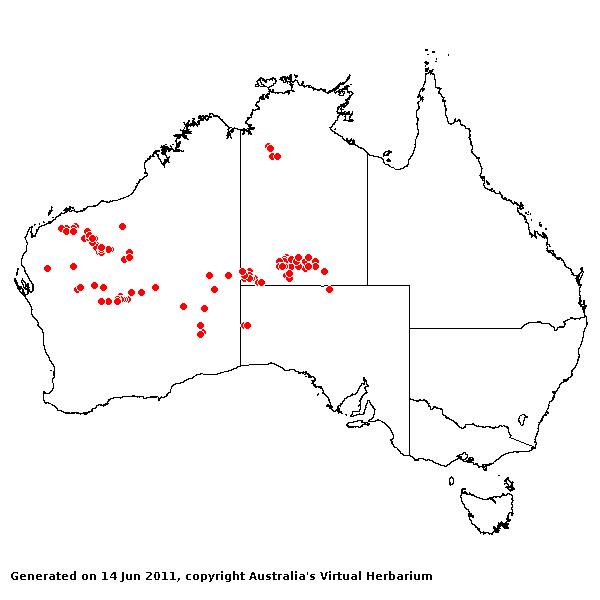Triodia melvillei
(C.E.Hubb.)Lazarides. Austral.
Syst. Bot. 10: 451
(1997).
Classification. (GPWG 2001) : Subfamily
Chloridoideae. Triodeae.
Basionym and/or
Replacement Name: Plectrachne
melvillei C.E. Hubb., Bull. Misc. Inform. Kew 1941: 28 (1941).
Type of Basionym or
Protologue Information: LT: Melville s.n., Jul 1937, Australia:
Western Australia: Wiluna Distr.: Eremaean Province, mostly associated with
Mulga (CANB; ILT: K (4 sheets), PERT (2 sheets)). LT designated by Lazarides,
Fl. Austral. 44B: 459 (2005).
Key references
(books and floras): [1952] C.A.Gardner, Flora of Western Australia 1
Gramineae (82 as Plectrachne), [1981] M.Lazarides in J.Jessop
(ed)., Flora of Central Australia (446 as Plectrachne), [2002]
D.Sharp & B.K.Simon, AusGrass, Grasses of Australia, [2006]
J.Jessop, G.R.M.Dashorst, F.M.James, Grasses of South Australia (415).
Illustrations:
[2005] K.Mallet (ed.), Flora of Australia 44B: Poaceae 3 (Fig.
38D-H), [2006] J.Jessop, G.R.M.Dashorst, F.M.James, Grasses of South
Australia (415, fig. 346).
Habit.
Perennial. Culms erect, 10–200 cm tall. Lateral branches simple. Leaf-sheaths
glabrous on surface. Leaf-sheath auricles absent. Ligule a fringe of hairs.
Leaf-blades curved or flexuous, aciculate, conduplicate, 15–34 cm long, 0.8–2
mm wide. Leaf-blade surface indumented.
Inflorescence.
Inflorescence compound, a panicle. Panicle linear or oblong, 8–28(–45) cm long,
2–4(–6) cm wide.
Spikelets.
Spikelets pedicelled. Fertile spikelets many flowered, with at least 2 fertile
florets (3–8), comprising 3–8 fertile floret(s), with diminished florets at the
apex, elliptic, laterally compressed or terete, 8–20 mm long.
Glumes. Glumes
similar. Lower glume lanceolate or elliptic, scarious, without keels, 3–7
-nerved. Lower glume apex muticous or mucronate or awned. Upper glume
lanceolate or elliptic, 6–12 mm long, scarious, without keels, 3–7 -nerved.
Upper glume apex entire or lobed, muticous or mucronate or awned.
Florets.
Fertile lemma 5–6 mm long, without keel, 9 -nerved. Lemma surface indumented.
Lemma apex lobed, awned, 3 -awned. Median (principal) awn 7–9 mm long overall.
Lateral lemma awns present. Palea 2 -nerved. Lodicules present. Anthers 3.
Continental
Distribution: Australasia.
Australian
Distribution: Western Australia, Northern Territory, South Australia.
Western Australia:
Mueller, Giles, Fortescue, Ashburton, Austin. Eucla. Northern Territory:
Darwin & Gulf, Victoria River, Central Australia South. South Australia:
North-western.
Notes.
Diagnostic characters include the lemmas often hairy in linear series; paleas
usually glabrous; lanceolate often closely flowered spikelets; resinous culms,
foliage, panicle and glumes; partly chartaceous flattened long-ciliate sheaths;
narrow dense panicles.
Mainly
recorded in the central Eremaean Province of W.A., the southern central part of
the N.T., and the North-West region of S.A. On plains, dunes and swales in red
sands, red earths and sandy loams; also on hillslopes, ridges, breakaways and
gorges in rocky, skeletal and stony soils, associated with laterite, sandstone,
quartzite, granite and calcareous sandstone; shores of inland lakes; flowers
all seasons; fruits all seasons.





